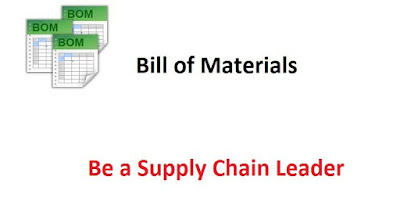Bill of Materials (BOM)
A bill of materials is used in the manufacturer of a product and should contain raw materials, sub-assemblies, subcomponents, parts and the quantities of each. Each line of the bill of materials (BOM) will include the part number of the item, description, quantity, unit of measure, and a procurement type which describes if the part is purchased or manufactured. There are a number of different types of bill of materials such as the engineering bill of materials, the manufacturing bill of materials, and the equipment bill of materials.
The different types of bill of materials depend on the business need and use for which they are intended.
Engineering Bill of Materials
The engineering bill of materials or engineering BOM defines the finished product as it was designed. The engineering BOM lists the items, parts, components, sub-assemblies, and assemblies in the product designed by engineering. The engineering BOM is often organized by engineers based on a Computer-Aided Design (CAD) drawing. For a finished product, there may be more than one engineering BOM created.
Manufacturing Bill of Materials
The manufacturing bill of materials, also referred to as the manufacturing BOM, contains all the parts and assemblies required to build a complete and shippable product. This includes all the packaging materials required to ship the finished product to the customer. The bill of materials will also include any processes that need to be performed on the item before it is completed. The manufacturing bill of materials stores all the information required for manufacturing activities. When MRP is run the bill of materials are exploded for the finished products that have been ordered by customers. The MRP process takes the details from the manufacturing bill of materials and calculates, based on the suggested delivery date to the customer, whether materials are needed to be purchased and when the manufacturing order needs to be started.
Configurable Bill of Materials
It is possible to have a bill of material for a finished product that can be configured to a specific requirement for a customer. The configurable bill of material contains all the components that are required to manufacture the material to a customer's specific requirements.
A bill of materials is used in the manufacturer of a product and should contain raw materials, sub-assemblies, subcomponents, parts and the quantities of each. Each line of the bill of materials (BOM) will include the part number of the item, description, quantity, unit of measure, and a procurement type which describes if the part is purchased or manufactured. There are a number of different types of bill of materials such as the engineering bill of materials, the manufacturing bill of materials, and the equipment bill of materials.
The different types of bill of materials depend on the business need and use for which they are intended.
Engineering Bill of Materials
The engineering bill of materials or engineering BOM defines the finished product as it was designed. The engineering BOM lists the items, parts, components, sub-assemblies, and assemblies in the product designed by engineering. The engineering BOM is often organized by engineers based on a Computer-Aided Design (CAD) drawing. For a finished product, there may be more than one engineering BOM created.
Manufacturing Bill of Materials
The manufacturing bill of materials, also referred to as the manufacturing BOM, contains all the parts and assemblies required to build a complete and shippable product. This includes all the packaging materials required to ship the finished product to the customer. The bill of materials will also include any processes that need to be performed on the item before it is completed. The manufacturing bill of materials stores all the information required for manufacturing activities. When MRP is run the bill of materials are exploded for the finished products that have been ordered by customers. The MRP process takes the details from the manufacturing bill of materials and calculates, based on the suggested delivery date to the customer, whether materials are needed to be purchased and when the manufacturing order needs to be started.
Configurable Bill of Materials
It is possible to have a bill of material for a finished product that can be configured to a specific requirement for a customer. The configurable bill of material contains all the components that are required to manufacture the material to a customer's specific requirements.

Thanks for sharing about useful content
ReplyDeleteInventory Software